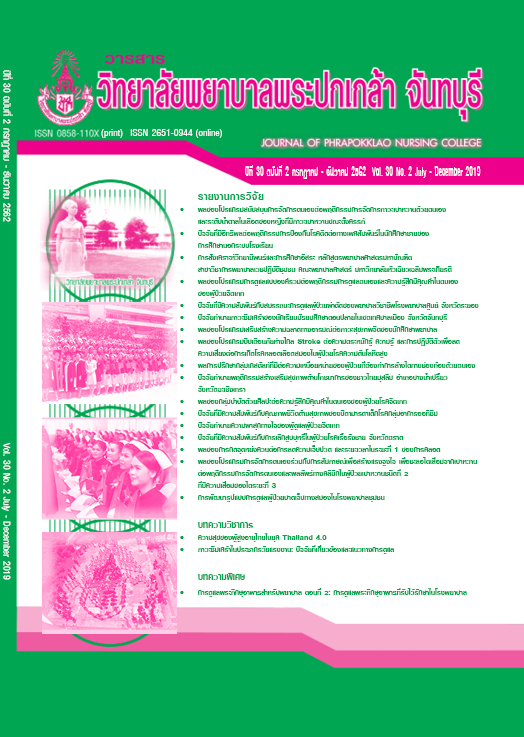Effect of Art Therapy Group on Self-esteem among Patients with Schizophrenia
Keywords:
Art therapy group, Self-esteem, Patient with schizophreniaAbstract
This quasi-experimental research aimed to examine the effect of art therapy group on self-esteem among patients with schizophrenia. The participants included 20 patients with schizophrenia receiving services in in-patient department at Sakaeo Rajanagarindra Psychiatric Hospital and were equally divided into an experimental group (n = 10) and a control group (n = 10). The research instruments comprised the art therapy group, the Brief Psychiatric Rating Scale (BPRS), a questionnaire of demographic data, and a scale of self-esteem with the reliability of .84. The implementation and data collection were conducted from October to December, 2016. Statistics used for data analysis included frequency, percentage, mean, standard deviation, independent t-test, and two-way repeated measures ANOVA with multiple comparisons by Bonferroni.
The research results revealed that 1) at post-test and 1-month follow-up period, the experimental group had statistically significant higher mean score of self-esteem than the control group (p < .01); and 2) at post-test and 1-month follow-up period, the experimental group had statistically significant higher mean score of self-esteem than the pre-test period (p < .01).
This research suggests that health care providers should apply this art therapy group in caring for patients with schizophrenia in order to enhance their self-esteem.
References
กรมสุขภาพจิต. (2559). สถิติผู้ป่วยที่มารับบริการโรงพยาบาลสังกัดกรมสุขภาพจิต. นนทบุรี: ผู้แต่ง.
เครเมอร์, อี. (2552). ศิลปะเพื่อการบำบัด [Art as therapy: Collected papers] (เลิศศิริร์ บวรกิตติ, ผู้แปลและเรียบเรียง). กรุงเทพฯ: กรุงเทพเวชสาร.
ดวงจันทร์ จงรักษ์. (2549). ทฤษฎีการให้การปรึกษาและจิตวิทยาเบื้องต้น. กรุงเทพฯ: สมาคมส่งเสริมเทคโนโลยี (ไทย-ญี่ปุ่น).
นปภัช กันแพงศรี. (2557). ผลของโปรแกรมกิจกรรมศิลปะต่อการเห็นคุณค่าในตนเองของผู้สูงอายุที่มีภาวะสมองเสื่อมระยะแรก (วิทยานิพนธ์ปริญญามหาบัณฑิต). กรุงเทพฯ: จุฬาลงกรณ์มหาวิทยาลัย.
นาตยา วงศ์หลีกภัย. (2532). ผลของกลุ่มจิตสัมพันธ์ที่มีต่อการเห็นคุณค่าในตนเองของวัยรุ่น (วิทยานิพนธ์ปริญญามหาบัณฑิต). กรุงเทพฯ: จุฬาลงกรณ์มหาวิทยาลัย.
นิดารัตน์ ชูวิเชียร. (2550). ผลของศิลปะบำบัดต่อความรู้สึกมีคุณค่าในตนเองของเด็กวัยรุ่นที่ถูกล่วงละเมิดทางเพศ (วิทยานิพนธ์ปริญญามหาบัณฑิต). มหาวิทยาลัยเชียงใหม่.
เปรมฤดี ดำรักษ์, อังคณา วังทอง, และอนุชิต วังทอง. (2557). การมีส่วนร่วมของชุมชนในการดูแลผู้ป่วยจิตเภทเรื้อรังซับซ้อน อำเภอหนองจิก จงหวัดปัตตานี. วารสารสมาคมนักวิจัย, 19(2), 92-103.
ผ่องศรี ดวงแก้ว. (2553). การวิเคราะห์สถานการณ์การเกิดตราบาปของผู้ที่เป็นโรคจิตเภทในโรงพยาบาลสวนปรุง จังหวัดเชียงใหม่ (วิทยานิพนธ์ปริญญามหาบัณฑิต). มหาวิทยาลัยเชียงใหม่.
พันธุ์นภา กิตติรัตนไพบูลย์. (2544). โครงการอบรมแนวทางการสัมภาษณ์และให้คะแนน BPRS ในรูปแบบของ T-PANSS. ใน เอกสารประกอบการบรรยายเรื่องการประเมินอาการผู้ป่วยจิตเวช โรงพยาบาลสวนปรุง (น. 1-10). เชียงใหม่: โรงพยาบาลสวนปรุง.
พิเชฐ อุดมรัตน์, และสรยุทธ วาสิกนานนท์. (2552). ตำราโรคจิตเภท. สงขลา: ชานเมืองการพิมพ์.
มาโนช หล่อตระกูล, และปราโมทย์ สุคนิชย์. (บ.ก.). (2555). จิตเวชศาสตร์ รามาธิบดี (พิมพ์ครั้งที่ 3). กรุงเทพฯ: บียอนด์ เอ็นเทอร์ไพรซ์.
รัฐ ลอยสงเคราะห์. (2552). ผลของศิลปะบำบัดต่อการเห็นคุณค่าในตนเองของผู้ติดสารเสพติดชาย สถาบันธัญญารักษ์ (วิทยานิพนธ์ปริญญามหาบัณฑิต). กรุงเทพฯ: จุฬาลงกรณ์มหาวิทยาลัย.
โรงพยาบาลจิตเวชสระแก้วราชนครินทร์. (2559). รายงานประจำปีงบประมาณ 2559. สระแก้ว: ผู้แต่ง.
หทัยรัตน์ ปฏิพัทธ์ภักดี. (2554). การเสริมสร้างพลังอำนาจในผู้ป่วยจิตเภทเรื้อรังหญิงที่มีคุณค่าในตนเองต่ำ (การศึกษาอิสระปริญญามหาบัณฑิต). มหาวิทยาลัยขอนแก่น.
American Psychiatric Association. (2000). Diagnostic and statistical manual of mental disorders (4th ed.). Washington, DC: Author.
Brooke, S. L. (1995). Art therapy: An approach to working with sexual abuse survivors. The Arts in Psychotherapy, 22(5), 447-466.
Corring, D. J., & Cook, J. V. (2007). Use of qualitative methods to explore the quality-of-life construct from a consumer perspective. Psychiatric Services, 58(2), 240-244.
Polit, D. F., & Hungler, B. P. (2001). Nursing research: Principles and methods (6th ed.). Philadelphia: J. B. Lippincott.
Varcarolis, E. M., Carson, V. B., & Shoemaker, N. C. (2006). Foundation of psychiatric mental health nursing: A clinical approach. St. Louis: Elsevier.
Downloads
Published
How to Cite
Issue
Section
License
Copyright (c) 2019 JOURNAL OF PHRAPOKKLAO NURSING COLLEGE

This work is licensed under a Creative Commons Attribution-NonCommercial-NoDerivatives 4.0 International License.
เนื้อความ ข้อมูล และรายการอ้างอิงที่ผู้เขียนใช้ในการเขียนบทความเพื่อลงตีพิมพ์ในวารสารวิทยาลัยพยาบาลพระปกเกล้า จันทบุรี ถือเป็นความคิดเห็นและความรับผิดชอบของผู้เขียน คณะผู้จัดทำวารสารไม่จำเป็นต้องเห็นพ้องด้วยหรือร่วมรับผิดชอบ
บทความที่ได้รับการลงตีพิมพ์ในวารสารวิทยาลัยพยาบาลพระปกเกล้า จันทบุรี ถือเป็นลิขสิทธิ์ของวารสารวิทยาลัยพยาบาลพระปกเกล้า จันทบุรี หากหน่วยงานหรือบุคคลใดต้องการนำส่วนหนึ่งหรือทั้งหมดของบทความไปเผยแพร่ต่อเพื่อวัตถุประสงค์ใด ๆ จะต้องได้รับอนุญาตจากบรรณาธิการวารสารก่อน



